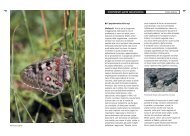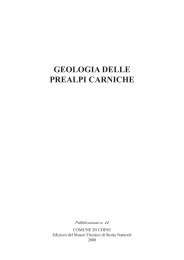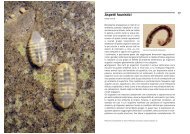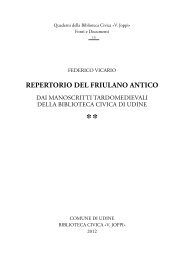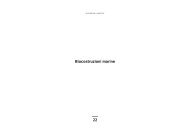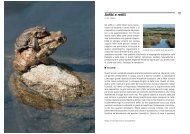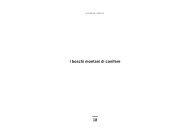Despite its inhospitable appearance and lack of any ... - Udine Cultura
Despite its inhospitable appearance and lack of any ... - Udine Cultura
Despite its inhospitable appearance and lack of any ... - Udine Cultura
You also want an ePaper? Increase the reach of your titles
YUMPU automatically turns print PDFs into web optimized ePapers that Google loves.
44 45<br />
Methods for sampling <strong>and</strong> analysing groundwater fauna<br />
Fabio Stoch<br />
Groundwater habitats are difficult to<br />
reach, <strong>and</strong> researchers have had to<br />
come up with ingenious methods for<br />
sampling <strong>and</strong> analysing underground<br />
fauna which, according to the depth <strong>and</strong><br />
accessibility <strong>of</strong> aquifers, are sometimes<br />
expensive <strong>and</strong> so complex that only<br />
specialised research institutes can carry<br />
them out.<br />
In karstic waters, traditional sampling<br />
methods include:<br />
● continuous filtering <strong>of</strong> trickling water<br />
funnelled into containers with filters<br />
which are periodically emptied;<br />
● collection <strong>of</strong> percolating water in<br />
gours <strong>and</strong> micro-gours, by means <strong>of</strong><br />
rubber pumps or syringes;<br />
filtering <strong>of</strong> concretion water with<br />
plankton nets (60-100-µm mesh) which<br />
are emptied with rubber piping;<br />
● direct filtering <strong>of</strong> water from large<br />
pools with plankton nets with h<strong>and</strong>les;<br />
● in streams <strong>and</strong> small watercourses:<br />
after coarse debris has been shaken out,<br />
water is filtered through plankton nets<br />
(with semi-circular openings 20-25 cm in<br />
diameter);<br />
● direct collection <strong>of</strong> large organisms<br />
with aquarium nets <strong>and</strong> tweezers;<br />
● in order to collect large predatory<br />
crustaceans (1), traps containing meat or<br />
tid-b<strong>its</strong> <strong>of</strong> food can be placed in suitable<br />
positions in open cans (to avoid the<br />
death <strong>of</strong> animals trapped inside, if the<br />
trap <strong>its</strong>elf is lost);<br />
● placing artificial substrates (twisted<br />
nylon netting compressed in tubes, or<br />
tubes filled with locally collected washed<br />
sediment) which are periodically emptied<br />
in order to analyse the colonisation <strong>of</strong><br />
various types <strong>of</strong> substrates.<br />
Collecting specimens from wells or<br />
boreholes in alluvial soils may be carried<br />
out with:<br />
● modified plankton nets (Cvetkov nets)<br />
with valves to prevent material from<br />
escaping when the nets are quickly lifted<br />
<strong>and</strong> replaced on the bottom <strong>of</strong> the well<br />
to agitate the sediments (2);<br />
● various types <strong>of</strong> pumps (peristaltic,<br />
rotor, compressed-air), according to<br />
water-table depth (rotor pumps <strong>of</strong><br />
greater power unfortunately easily<br />
destroy material).<br />
Lastly, in flooding watercourses where<br />
collection is concentrated in upwelling or<br />
outwelling stretches (see chapter on<br />
ecology), two methods are used:<br />
● Karaman-Chappuis method: a hole is<br />
dug along the shore <strong>of</strong> a watercourse,<br />
<strong>and</strong> the water permeating from nearby<br />
sediments is collected <strong>and</strong> filtered<br />
through a plankton net;<br />
● Bou-Rouch method: a h<strong>and</strong>-pump (3)<br />
is used to remove interstitial water from<br />
the bed <strong>of</strong> a watercourse, by means <strong>of</strong> a<br />
Filtering trickling water with a plankton net Equipment for sample collection<br />
1<br />
2<br />
perforated tube inserted deeply into the<br />
sediments (for a detailed description <strong>of</strong><br />
this method, see Teaching Suggestions).<br />
Research teams with the most recent<br />
equipment can use drills to place<br />
piezometers at varying depths, from<br />
which groundwater is extracted with<br />
pumps <strong>and</strong> filtered through plankton<br />
nets.<br />
Other, quite expensive methods, like<br />
freeze-coring, use liquid nitrogen to<br />
freeze sediment cores collected from<br />
boreholes <strong>and</strong> subsequently examined<br />
in the laboratory.<br />
More advanced research methods<br />
involve inserting transparent perspex<br />
piezometers with optical-fibre videocameras<br />
into the soil or sediment in the<br />
river bed. In this way, researchers can<br />
analyse large organisms in their natural<br />
environment without disturbing the<br />
underground community.<br />
3




